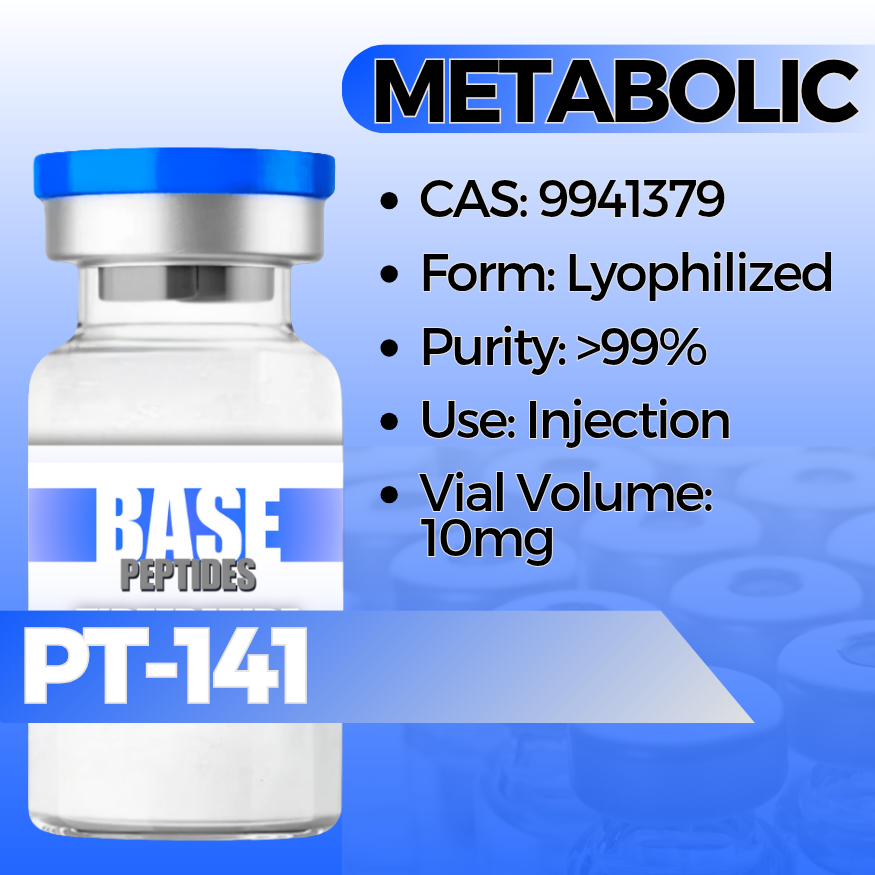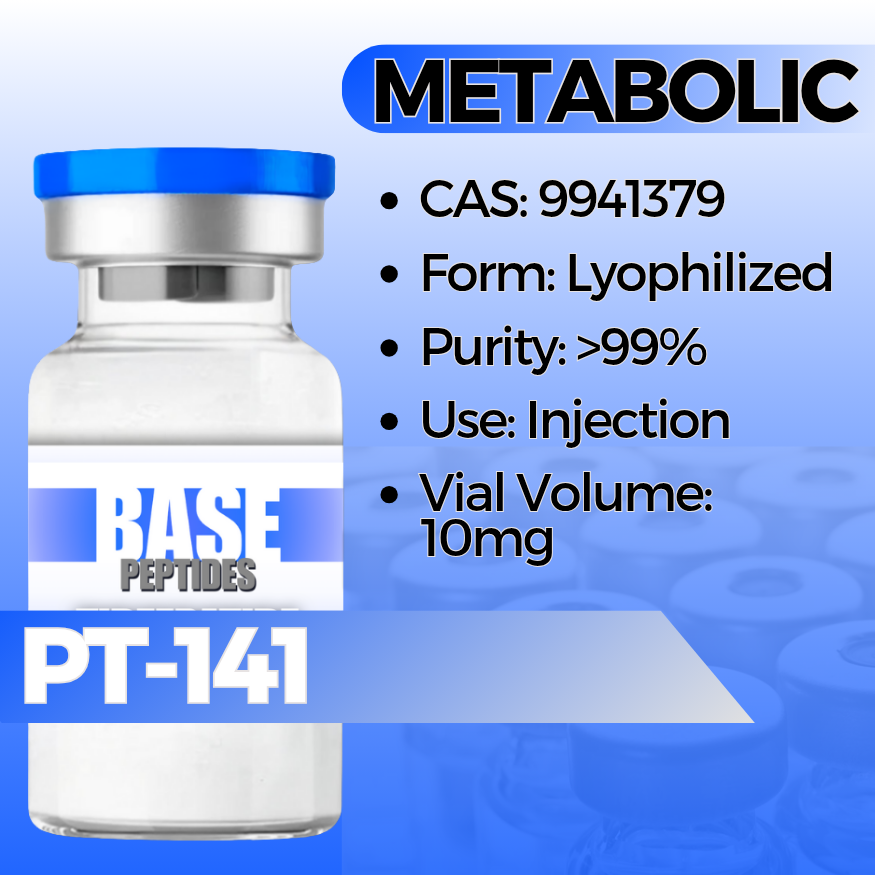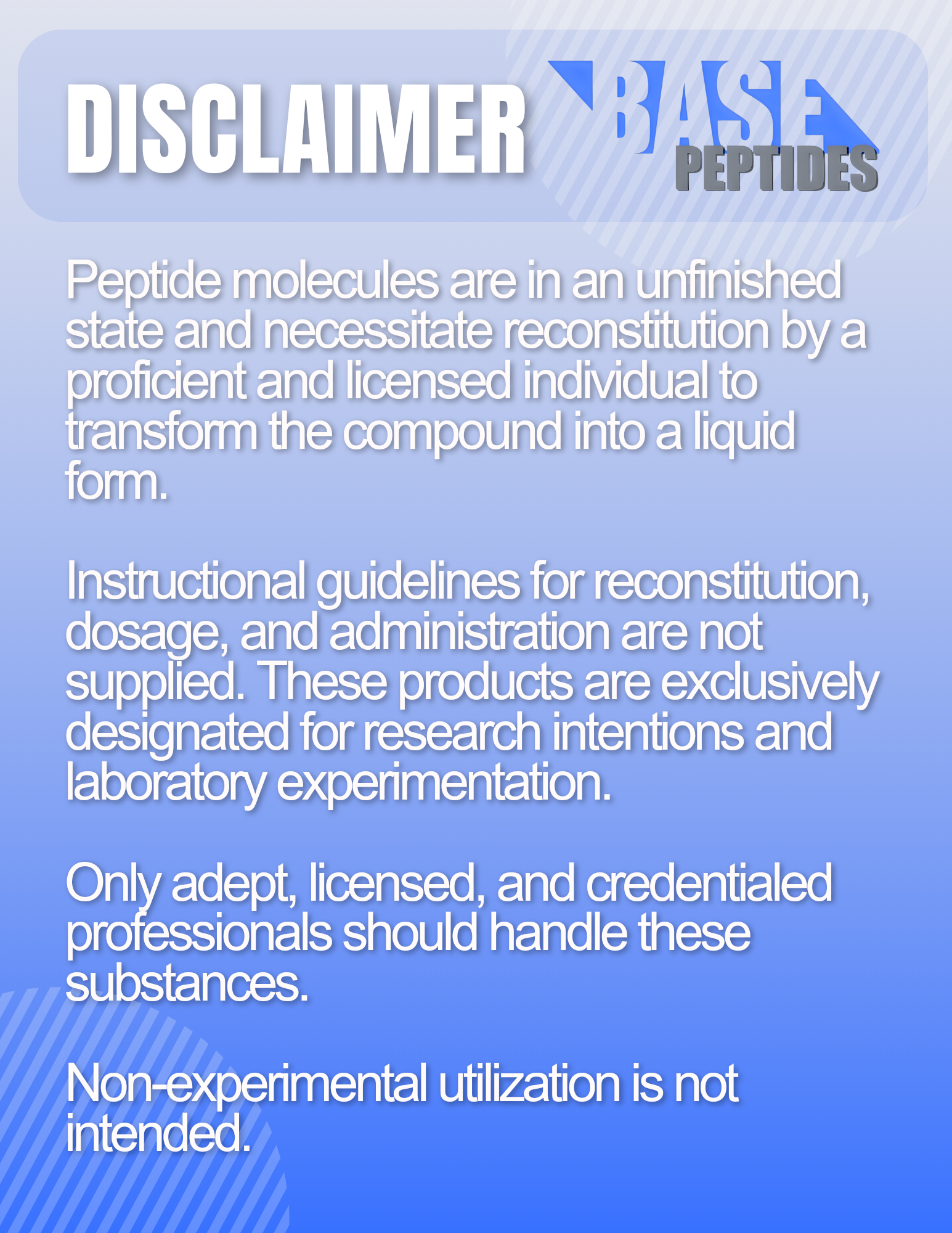PT-141
PT-141
Base Peptides are intended for licensed medical professionals and experienced researchers. Reconstitution required. Dosing and use instructions are not provided.
Couldn't load pickup availability
PT-141 (Bremelanotide) — Cyclic Heptapeptide Melanocortin Agonist
PT-141 (Bremelanotide) is a cyclic heptapeptide derived from the melanocortin family and studied for central melanocortin (MC) pathway activation, especially MC3R/MC4R in the brain. Research focuses include sexual behavior neurobiology, energy-balance signaling, and melanocortin receptor pharmacology. [oai_citation:0‡PMC](https://pmc.ncbi.nlm.nih.gov/articles/PMC8788464/?utm_source=chatgpt.com)
- CAS: 189691-06-3 [oai_citation:1‡Wikipedia](https://en.wikipedia.org/wiki/Bremelanotide?utm_source=chatgpt.com)
- PubChem CID: 9941379 [oai_citation:2‡PubChem](https://pubchem.ncbi.nlm.nih.gov/compound/Bremelanotide?utm_source=chatgpt.com)
- Formula / MW: C50H68N14O10 · ~1025 g·mol⁻¹ (free base) [oai_citation:3‡PubChem](https://pubchem.ncbi.nlm.nih.gov/compound/Bremelanotide?utm_source=chatgpt.com)
- Sequence: Ac-Nle-cyclo[Asp-His-D-Phe-Arg-Trp-Lys]-OH (α-MSH analogue) [oai_citation:4‡FDA Access Data](https://www.accessdata.fda.gov/drugsatfda_docs/nda/2019/210557Orig1s000OtherR.pdf?utm_source=chatgpt.com)
- Common names: PT-141; Bremelanotide (USAN); tradename “Vyleesi” (device/finished drug). [oai_citation:5‡Wikipedia](https://en.wikipedia.org/wiki/Bremelanotide?utm_source=chatgpt.com)
- Acts as a melanocortin receptor agonist, with predominant activity at MC3R/MC4R, pathways tied to sexual behavior circuits and energy homeostasis. [oai_citation:6‡PMC](https://pmc.ncbi.nlm.nih.gov/articles/PMC8788464/?utm_source=chatgpt.com)
- Unlike peripherally focused agents, PT-141’s effects are studied mainly via central receptor signaling (hypothalamic networks). [oai_citation:7‡PMC](https://pmc.ncbi.nlm.nih.gov/articles/PMC2694735/?utm_source=chatgpt.com)
- As an α-MSH-family analogue, it lacks vasodilator/NO dependence—useful for dissecting non-NO sexual arousal mechanisms in models. [oai_citation:8‡PMC](https://pmc.ncbi.nlm.nih.gov/articles/PMC2694735/?utm_source=chatgpt.com)
- To probe MC3R/MC4R pharmacology and neural circuits regulating arousal, appetite, and stress response. [oai_citation:9‡PMC](https://pmc.ncbi.nlm.nih.gov/articles/PMC8788464/?utm_source=chatgpt.com)
- To build translational bridges from receptor activation → behavioral endpoints (questionnaires, neuroendocrine measures). [oai_citation:10‡PubMed](https://pubmed.ncbi.nlm.nih.gov/31599840/?utm_source=chatgpt.com)
- To compare melanocortin agonists (e.g., setmelanotide for MC4R) across energy-balance pathways. [oai_citation:11‡ScienceDirect](https://www.sciencedirect.com/science/article/pii/S2212877821000466?utm_source=chatgpt.com)
Key Studies — What Was Tested, What Changed, Why It Matters
Phase 3 HSDD trials (human) — central MC pathway engagement
- What was tested: Two randomized, double-blind, placebo-controlled Phase 3 trials in premenopausal women with HSDD. [oai_citation:12‡PubMed](https://pubmed.ncbi.nlm.nih.gov/31599840/?utm_source=chatgpt.com)
- What changed: Significant improvements on sexual-desire and distress scales vs placebo; most AEs were mild–moderate (nausea, flushing, headache). [oai_citation:13‡PubMed](https://pubmed.ncbi.nlm.nih.gov/31599840/?utm_source=chatgpt.com)
- Why it matters: Confirms that **melanocortin signaling** can modulate human arousal endpoints—useful for mechanistic and translational research frameworks.
Mechanism & safety context from FDA dossiers
- What was reviewed: FDA label/NDAs summarizing PK/PD and safety signals in clinical use. [oai_citation:14‡FDA Access Data](https://www.accessdata.fda.gov/drugsatfda_docs/label/2019/210557s000lbl.pdf?utm_source=chatgpt.com)
- What changed: Repeated finding of transient BP increases and HR reduction post-dose; labeling warns against use in uncontrolled hypertension. [oai_citation:15‡FDA Access Data](https://www.accessdata.fda.gov/drugsatfda_docs/label/2019/210557s000lbl.pdf?utm_source=chatgpt.com)
- Why it matters: For lab work, plan cardiovascular monitoring endpoints if your model requires systemic exposure.
Potential Research Applications
Neurobehavioral Models
- Central MC3R/MC4R pathway studies
- Behavioral assays + endocrine readouts
Energy-Balance & Stress
- MC4R-linked feeding/energy studies (comparators like setmelanotide)
- HPA-axis and autonomic endpoints
Receptor Pharmacology
- Agonist selectivity (MC1R–MC5R) & biased signaling
- Off-target pigmentation pathways (context-dependent)
Synergistic Peptides (for Study Design)
Oxytocin
- Why pair: Complementary neuropeptide for social/affiliative circuits alongside melanocortin pathways.
- Angle: Cross-over designs to parse amygdala–hypothalamus networks.
Selank / Semax
- Why pair: Neuroimmune/neurotrophic modulators to profile mood-stress context alongside arousal endpoints.
- Angle: Cytokine/BDNF arrays + behavioral tasks.
Setmelanotide
- Why pair: MC4R-selective comparator to contrast **selectivity vs breadth** within the melanocortin family. [oai_citation:16‡ScienceDirect](https://www.sciencedirect.com/science/article/pii/S2212877821000466?utm_source=chatgpt.com)
- Angle: Side-by-side receptor occupancy and downstream signaling.
Design Notes
- Declare salt/form (e.g., acetate) and vehicle; peptide adsorption and pH matter.
- For systemic models, predefine cardiovascular endpoints (BP/HR) given label findings. [oai_citation:17‡FDA Access Data](https://www.accessdata.fda.gov/drugsatfda_docs/label/2019/210557s000lbl.pdf?utm_source=chatgpt.com)
- Use appropriate controls (vehicle, single-agent comparators) for mechanism clarity.
Known Concerns (Context)
- Transient cardiovascular effects: Short-lived increases in blood pressure and reductions in heart rate reported post-dose. [oai_citation:18‡FDA Access Data](https://www.accessdata.fda.gov/drugsatfda_docs/label/2019/210557s000lbl.pdf?utm_source=chatgpt.com)
- Nausea/headache & hyperpigmentation: Common tolerability signals; pigmentation is mechanism-linked in some models. [oai_citation:19‡PMC](https://pmc.ncbi.nlm.nih.gov/articles/PMC8788464/?utm_source=chatgpt.com)
- General: Research use only; not for human consumption or therapeutic use.
Specifications & Handling
- Form: Lyophilized powder (lot-coded)
- Purity: ≥ 99% (HPLC/MS verified)
- Storage: ≤ −20 °C; protect from light/moisture
- In solution: Prepare fresh aliquots; avoid repeat freeze–thaw
- Packaging: Tamper-evident; research-only labeling
Regulatory & Use Notice
Sold for laboratory research use only. Not for human consumption, medical, or veterinary use. No human-use instructions are provided. Buyer is responsible for safe handling and regulatory compliance.
PT-141 (Bremelanotide) Peptide Research | Melanocortin (MC3R/MC4R) Agonist | Neurobehavior & Energy-Balance Studies






